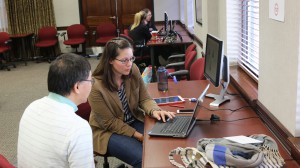At our November Faculty Showcase, we gave thanks for the many ways technology makes us more efficient, productive, and engaging instructors. Special thanks to Kate Pfile, Mary Ann Hartshorn, and Gayle Goudy for sharing their experiences using instructional technologies. In addition to learning about innovative teaching strategies, we also collected over 34 pounds of canned goods to be donated in time for Thanksgiving. Thank you to everyone who contributed!

During the Showcase, Kate Pfile (HHP) showed us how her students use Popplet (Free; iOS and Web) for a postural assessment assignment. Popplet is a digital mind-mapping application that allows users to visually capture ideas and make connections between them. Kate asks her students to take pictures of a friend’s posture, then use Popplet to analyze musculature by identifying the relationships among various body parts. Popplet can also be used to enhance brainstorming, tease out ideas, plan projects, and organize one’s thoughts, such as when writing a research paper. Even better, Popplet allows multiple users to collaborate synchronously or asynchronously, so small groups or an entire class could work together.

Gayle Goudy (SOTA) shared her experiences with flipping her art history courses. Flipping has become a hot topic in education, as instructors move lectures outside the classroom while reserving class time for discussion, problem-solving, activities, and group work. This allows students to accomplish the lower levels of Bloom’s Taxonomy on their own while they work through higher levels of cognitive work with their classmates and instructor. There are a variety of approaches to flipping your course, whether you want to flip the entire semester or just a handful of classes. TLT can point you to numerous technology tools that will facilitate this change, including Voicethread and Kaltura Mediaspace.

Mary Ann Hartshorn (TEDU) is a TLT Superstar: she presented at both of our Faculty Showcases this semester! Mary Ann shared how she uses Google Docs for a collaborative annotated bibliography assignment and the OAKS Discussion tool to encourage community-formation. To read more, check out our recap of the October Faculty Showcase.
TLT’s instructional technologists also had tech tools to share. Laura Plotts, instructional technologist for LCWA, showed faculty how Haiku Deck (Free; iOS and Web) provides a fantastic alternative to “death by Powerpoint.” With Haiku Deck, there’s no chance of presenting slides crammed with bullet points. Instead, the application forces users to keep text to a minimum and use images to tell their story. If you want students to learn to speak extemporaneously, Haiku Deck can help wean them off of reading directly from their slides. Because of its eye-catching designs and graphics, it’s also perfect for video lectures, conference presentations, sales pitches, and keynote addresses.
Kaitlin Woodlief, instructional technologist for SSM, shared a tool that allows instructors to collect real-time feedback without the need for student devices. Plickers (Free; Android and iOS) makes formative assessment and live polling simple.
Students don’t need iPads or smartphones; instead, each student responds by holding up a card that’s printed with a special image that has letters around the sides. If, for example, the answer to the question is A, the student will turn the card so that the letter A is on top.
The instructor then uses their smartphone or iPad camera to scan the room and capture the cards. The app registers the student answers which then can be displayed to the room. For those who worry about their entire class having devices, or those who simply don’t want to bother with students having to log in or register, Plickers may be just what you’re looking for.

If you’d like to learn more about any of these tools and strategies, please contact your instructional technologist. Thank you to everyone who stopped by! Be on the look-out for our Spring Faculty Showcases, including a few new, exciting events!











